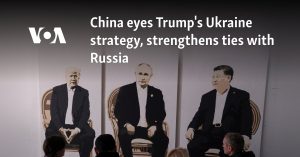The fate of Taiwan keeps American policymakers up at night, and it should. A Chinese invasion of the island would confront the United States with one of its gravest foreign policy choices ever. Letting Taiwan fall to Beijing would dent Washington’s credibility and create new challenges for U.S. military forces in Asia. But the benefits of keeping Taiwan free would have to be weighed against the costs of waging the first armed conflict between great powers since 1945. Even if the United States prevailed—and it might well lose—an outright war with China would likely kill more Americans and destroy more wealth than any conflict since the Vietnam War and perhaps since World War II. Nuclear and cyber weapons could make it worse, bringing destruction on the U.S. homeland. These would be catastrophic consequences for the United States.
As terrible as a U.S.-Chinese war would be, an American president would face immense pressure to fight for Taipei. Many U.S. policymakers are convinced that Taiwan, a prosperous democracy in a vital region, is worth protecting despite the daunting price of doing so. Political calculations may also push a U.S. president into war. By staying out, the president could expect to be blamed not only for permitting the economic meltdown that China’s invasion would trigger but also for losing Taiwan after a decades-long battle of wills between Washington and Beijing over the island’s future. That would doom a president’s legacy. Against such a certainty, any chance of salvaging the situation could look like a better bet—and by opting to fight China to protect Taiwan, the president would preserve the possibility of going down in history as a great wartime victor. In the 1960s, President Lyndon Johnson faced a choice between ramping up a U.S. military campaign in Vietnam and allowing the Communists to take over the country. He doubted that a war was necessary or winnable. But he sent American soldiers all the same.
U.S. leaders need a way to escape the ghastly decision to either wage World War III or watch Taiwan go down. They need a third option. Washington must make a plan that enables Taiwan to mount a viable self-defense, allows the United States to assist from a distance, and keeps the U.S. position in Asia intact regardless of how a cross-strait conflict concludes. This way, the United States could abstain from sending its military forces to defend Taiwan if China invades the island and does not attack U.S. bases or warships.
The Trump administration should launch an effort now to make this third option viable. Washington should condition its aid on defense spending and reforms in Taipei, pushing Taiwan into a position to better protect itself. It must also develop capabilities and plans to resupply the island if needed.
Yet U.S. policymakers must also accept that, without direct U.S. military intervention, Taiwan may manage only to stall a Chinese invasion, not repel one. The United States therefore needs to insulate its regional interests from Taiwan’s fate. Instead of clarifying its commitment to defend Taiwan, Washington should retain an ambiguous stance and downplay the importance of keeping the island out of Beijing’s hands. It should, meanwhile, bolster the self-defenses of its other Asian allies and partners, blocking any path for China to convert a successful bid for Taiwan into regional dominance. At home, U.S. politicians and analysts should speak frankly about the cost of a war with China and push back against the misguided idea that the United States’ survival and prosperity turn on Taiwan’s political status. Through a policy of firm but limited support for Taiwan, the United States can avoid involvement in a world-rending war while putting China off a risky invasion—and safeguarding U.S. interests if an invasion comes anyway.
PRICING IN WORLD WAR III
The United States rightly expends considerable resources to dissuade China from using coercion to control Taiwan. If China were to seize Taiwan, the United States would suffer significant military, economic, and reputational setbacks. China would gain a new foothold from which to project power across East Asia, complicating U.S. military operations in the region. Beijing could disrupt trade routes in the western Pacific, rattling the global economy. U.S. allies would have a new reason to question Washington’s commitment to their security. The repercussions would be greatest, of course, for the people of Taiwan, who would lose their vibrant democracy.
Nevertheless, for the foreseeable future, the benefits of preserving Taiwan’s de facto self-rule do not warrant the enormous human and economic costs of a U.S.-Chinese war. The United States’ vital interest lies in preventing China from attaining untrammeled regional hegemony in Asia. With such dominance, China could project large-scale military power into the Western Hemisphere or cut the United States off from Asia’s dynamic economic markets. But controlling Taiwan would not, in itself, transform China into a hegemon. The United States would remain capable of rallying a counterbalancing coalition to impede any potential Chinese bid for political and military supremacy in Asia.
For one thing, the military advantages China would reap from taking Taiwan would not be that profound, and the United States and its allies would have time to adjust. Beijing could use control of the island to expand the reach of its missiles, air defenses, radars, and maritime and air surveillance systems, allowing the People’s Liberation Army to operate farther from China’s coast and more easily hold at risk U.S. military assets, including bases in Guam and vessels near Japan and the Philippines. But the PLA’s weapons can already reach these U.S. targets, so adding a few hundred more miles to their range would make only a marginal difference. China’s undersea gains would be similarly modest and unlikely to offset U.S. advantages. Seizing Taiwan would allow China to dock submarines in the deepwater ports off Taiwan’s eastern coast, which would extend their range and enable them to avoid some U.S. underwater sensors in the Miyako and Luzon Straits. They might not evade U.S. monitoring entirely, however, because satellites or sound surveillance in the region could probably detect them. Moreover, China may, in time, develop quieter submarines, and these could avoid U.S. detection without being launched from Taiwan.
U.S. politicians should speak frankly about the cost of a war with China.
Such limited operational gains would not give China the ability to bring about a dramatic regional expansion. Despite the fears of some in Tokyo and Manila, China would still face formidable obstacles to seizing outlying territories belonging to Japan or the Philippines—most of which are farther from Taiwan than Taiwan is from China—let alone more distant and populous islands, such as Okinawa or Kyushu in Japan or Luzon in the Philippines. Furthermore, it would take China years to build the infrastructure needed to use Taiwan as a base for military operations; the United States and its partners would have plenty of time to prepare additional defenses. In short, control of the island would hardly overturn the military balance in the region. Countries threatened by China’s rise have to invest in security measures no matter what happens in and around Taiwan.
If military considerations do not necessitate the direct U.S. defense of Taiwan, neither do the economic stakes. National security officials who favor a strong U.S. commitment to Taiwan frequently cite their concern that China could commandeer high-tech assets on the island. Taiwan produces about 90 percent of the world’s most advanced chips, largely through the Taiwan Semiconductor Manufacturing Company. They argue that if Beijing gains control of TSMC, it could leap ahead in the global technology race, and Washington would lose its most important source of semiconductors, constraining U.S. economic growth and military innovation. TSMC, however, cannot operate without Western components and intellectual property, both of which could be immediately cut off after a Chinese invasion. These steps, of course, would disrupt the United States’ own chip supply chains. Fortunately, the United States is already preparing for the possibility of losing access to Taiwanese production by building semiconductor fabrication plants at home. Boston Consulting Group has estimated that the United States is on track to produce 28 percent of the world’s advanced semiconductors by 2032.
The United States similarly has little reason to fear that it would lose access to East Asia’s valuable economic markets if China controlled Taiwan. China likely already has the military capability to disrupt shipping through the narrow sea-lanes of the East China and South China Seas, yet it has not done so. Fully blocking traffic would be expensive and time-consuming for the PLA, even if China controlled Taiwan, and China’s own economy would suffer, too. If necessary, commercial ships headed for Japan or South Korea could take new routes, bypassing the South China Sea by traveling through the Indonesian and Philippine archipelagoes or around Papua New Guinea through the Solomon Sea.
Some argue that the United States must fight for Taiwan because a failure to do so would undermine U.S. credibility, driving countries in the region closer to China. This seems unlikely. India and Japan, two of the United States’ cornerstone partners in the Indo-Pacific, have a deep history of animosity toward Beijing and tend to respond forcefully to Chinese aggression. To prevent Asian countries from aligning with Beijing if it takes Taiwan, the United States should stop reinforcing the idea that its reputation hinges on the defense of Taiwan. Instead, it should focus on its larger objective—preventing Chinese regional dominance—and stake its credibility on that.
PLAYING PORCUPINE
Taiwan certainly matters to the United States—just not enough to justify a war with China. The U.S. government thus needs a new strategy to support the island’s defense without having American troops engage in combat. Of course, if China were to target American forces first, keeping out of the fight would become impossible. But Beijing would have reason to refrain from attacking U.S. forces if it believed there was a good chance that Washington might abstain from conflict. To make a Taiwan-led U.S.-supplied defense viable, the United States should adopt two policies over the next decade: insist that Taipei reorient and step up its defense efforts, and improve the Pentagon’s ability to send military supplies to Taiwan during a conflict without putting Americans in harm’s way.
Taiwan’s current defense strategy leaves it unprepared for a Chinese attack. Taipei spends a significant share of its resources on advanced equipment, such as F-16 fighter jets, Abrams tanks, and submarines, intended to fight China head-on. Taiwan cannot defeat a Chinese invasion this way. China could easily find and destroy big assets, and its much larger military force would overwhelm any of these systems that survive an initial attack, leaving Taiwan without offensive firepower or sufficient defenses. At that point, Taiwan’s survival would depend entirely on U.S. military warships and aircraft rapidly arriving and entering into the conflict—a massive gamble for Taipei and a devil’s choice for the United States.
Instead, as many analysts have argued, the best way for Taiwan to protect itself is to become a “porcupine” whose sharp defenses—large numbers of antiship missiles, sea mines, and air defense systems, for instance—can thwart an invader’s attempt to absorb the island. With this asymmetric denial defense, Taiwan’s military could prevent China from quickly seizing the island, dragging the PLA into a long and costly war that paves the way for a political settlement. Under the first Trump and the Biden administrations, Washington encouraged Taiwan to embrace such an approach, and Taipei made some progress, for example by investing in antiship missiles and starting to build a fleet of small drones. But change has been halting and insufficient.

The United States can spur Taiwan to acquire the capabilities it needs to become more self-reliant. Washington should clearly convey to Taipei that it will increase or decrease aid depending on how much Taiwan spends on its military and whether it invests in the right kinds of weapons and personnel to mount a denial-focused strategy. To turn up the pressure, U.S. leaders should publicly state that, although the United States has an abiding interest in maintaining the cross-strait status quo and a legal obligation under the Taiwan Relations Act to equip the island with defensive weapons, Taiwan bears the primary responsibility for its own defense.
To receive the maximum U.S. assistance on offer, Taiwan should be required to increase its defense spending from the roughly two and a half percent of GDP it spends today to at least four percent by 2030—a level of expenditure on par with that of other countries in precarious security environments. Israel spends about five percent of GDP on defense despite being far stronger than any of its adversaries. Poland and the Baltic states are working toward military spending of four percent of GDP even though they are protected by NATO’s security guarantee.
Just as important, the United States should condition military assistance on the extent to which Taiwan uses its expanded budget to prepare a denial defense. Taiwan will need to triple or quadruple its arsenal of antiship missiles to have a chance at disabling a significant number of the vessels China would use to move its forces onto Taiwan’s shores. Taipei should increase and modernize its stockpiles of naval mines, which would, in the event of an invasion, allow it to wreak further havoc on approaching Chinese ships. Taiwan should, at a minimum, double its supply of shoulder-fired and mobile air defense systems and purchase or manufacture thousands of the munitions they need. It will also have to acquire tens of thousands of cheap drones that can harass PLA aircraft as they try to control the skies over the island. This would inhibit China from relentlessly bombing Taiwan’s critical infrastructure or dropping paratroops inland. Finally, the United States should reject Taiwanese requests for big-ticket items such as aircraft and warships that would be easy targets for Chinese missiles and would be unlikely to withstand an initial Chinese attack. Washington should cancel unfilled Taiwanese orders for Abrams tanks and F-16 fighter jets and reallocate the funds to smaller, cheaper systems suited to a denial strategy.
In addition to setting spending targets, the United States should demand that Taiwan improve its military training so that it generates a large, reliable reserve force capable of holding off Chinese invaders. With enough skilled personnel, Taiwanese forces could occupy hardened positions along the island’s coast to prevent the PLA from amassing the numbers needed to break out from their beachheads and seize and hold territory farther inland. Responding to internal and external pressure, Taiwan lengthened its conscription term in 2024 from four months to one year for all Taiwanese men born after 2005 and updated the curriculum for conscripts and reservists to include some live-fire drills. But much of this training remains divorced from the realities of warfighting. For example, it focuses on the most basic military skills rather than offering the advanced field exercises that would prepare soldiers to operate in a conflict. In addition, only six percent of eligible conscripts reported for training last year; the rest received deferments to complete their education. To get Taiwan’s reserve force to its necessary size and readiness, the Trump administration should press Taipei to require two full years of more intense instruction and limit the use of deferments.
Controlling Taiwan would not, in itself, transform China into a hegemon.
The United States, for its part, must do all it can to equip Taiwan with asymmetric capabilities. Washington should make the island a priority recipient of arms sales, filling Taipei’s orders before those of other clients, just as the United States has done for Ukraine. U.S. suppliers can produce much of the materiel Taiwan needs most, such as antiship missiles, naval mines, and small air and sea drones, cheaply and in large quantities. The Biden administration transferred excess stocks of U.S. weapons to Taiwan, and the Trump administration should continue to do so. The United States should also invest in Taiwan’s defense industrial base so Taipei can produce and distribute munitions, spare parts, and medical supplies around the island during a conflict. This would also alleviate the burden on the United States’ own defense industrial base. Co-production arrangements and even joint ventures with U.S. firms could help Taiwan meet its needs.
Taiwan should become as self-reliant as possible, but the United States may still need the capability to replenish Taiwan’s military stockpiles during a Chinese blockade or under Chinese fire—without bringing U.S. forces into the conflict. Washington’s best option is to transport military supplies using uncrewed systems, including aircraft, surface vessels, and undersea vehicles, because even if the PLA fired on them, the United States would suffer no casualties and could avoid entering into a war. On the few occasions that adversaries have damaged U.S. drones, Washington has never retaliated with a direct military strike. During the war in Ukraine, for instance, a Russian fighter jet forced down a U.S. Reaper drone over the Black Sea, and the U.S. military did not respond.
Uncrewed vehicles tend to be smaller than crewed ones, but they can still carry essential items such as ammunition, shoulder-fired and other small missiles, and naval and antitank mines. Some uncrewed systems already exist: the U.S. Marine Corps has developed an autonomous vessel, modeled on the boats of drug smugglers, that can be remotely operated from thousands of miles away. The Pentagon should accelerate efforts to develop other such systems, working with traditional defense contractors and smaller startups to produce autonomous air and sea craft that can carry cargo.
For now, the military infrastructure on Taiwan’s eastern coast is limited, making it difficult to receive cargo during a war. Taiwan should build additional runways, reinforced aircraft hangars, shelters for ships and submarines, and more extensive roads leading to the rest of the island. At the same time, the United States should expand current plans to stockpile military equipment at facilities near Taiwan, including in Guam, Japan, the Marshall and Northern Mariana Islands, Palau, the Philippines, and South Korea. Where necessary, Washington should seek explicit permission from host countries for the U.S. military to conduct resupply missions there. So far, no country in the region has clearly and publicly pledged to provide this type of support in the event of a Taiwan contingency. Some may be leery of getting pulled into a conflict with China, but U.S. officials should make clear that Washington, too, is seeking to avoid direct intervention.
SELF-DEFENSE CLASS
In addition to reducing Taiwan’s dependence on U.S. military assistance, the United States should insulate its regional strategy from developments in Taiwan. That way, Washington can minimize the fallout in case Beijing succeeds in taking the island. In recent years, the Pentagon has adopted a Chinese invasion of Taiwan as its “pacing scenario,” the prospective future conflict on which U.S. budget and posture decisions are determined. Civilian leaders, meanwhile, speak more forcefully about their commitment to defend Taiwan than they did in previous decades. This approach has potential benefits. Demonstrating U.S. readiness and resolve over Taiwan may deter China from attempting an invasion by suggesting that the price would likely be direct war with the United States. But it also raises the risk of the worst outcome: that China is provoked into war and the United States is compelled to join that war out of fear that its credibility is on the line. To avoid such a calamity, Washington should change tack. The Trump administration should encourage countries in the region to become ready to defend themselves, and it should signal a more modest and ambiguous U.S. military commitment to Taiwan.
The balance of power in Asia does not hinge on control of Taiwan. More important are the United States’ ties to the major centers of economic and military power—Japan, India, and, to a lesser degree, South Korea—and countries such as Indonesia and the Philippines that are located on sea-lanes through which the United States gains commercial and military access to the region. Instead of planning to fight China in a war over Taiwan, the United States should prioritize shoring up the self-defense capabilities of these partners. Over the past few years, U.S. efforts to strengthen allied militaries have emphasized Taiwan-related scenarios. In the Philippines, the United States has concentrated investments in defense infrastructure in Luzon, the main territory closest to Taiwan, where the United States hopes to base missiles and personnel in a conflict. U.S. officials have likewise encouraged Japan to purchase cruise missiles that are capable of striking China. Yet Washington has paid insufficient attention to its allies’ most immediate security requirements. Manila needs to better protect bases and airfields across the Philippine archipelago, and Tokyo should bolster its air defenses and build munitions stockpiles.
The United States has also erred by expanding its military bases close to China and Taiwan. Washington has tried to gain more military access along the so-called first island chain, which encompasses the seas closest to the east coast of mainland China. The United States has also pushed increasingly powerful military hardware in greater quantities close to Chinese shores. Washington would be better served, instead, by reinforcing existing infrastructure where it is most defensible. The U.S. military should enhance airfields and ports, logistics and supply hubs, and pre-positioned military equipment in northern rather than southern Japan, and along the so-called second island chain, including Guam, the Marshall and Northern Mariana Islands, Micronesia, and Palau. China has fewer of the longer-range missiles needed to hit these distant and dispersed locations, making them more secure. By helping partners develop their own asymmetric defenses and protecting the U.S. military presence at better-defended bases farther from mainland China, the United States can both deter Beijing from widening a conflict over Taiwan and prevent it from achieving regional hegemony in any scenario, including if it gained control of the island.

For similar reasons, the Trump administration should take a public stance on cross-strait issues that is less provocative than the Biden administration’s. Over the last four years, the United States has effectively watered down its “one China” policy, which has long allowed Washington and Beijing to paper over their deep differences regarding Taiwan and avoid conflict. Under the policy, the United States acknowledges the Chinese position that Taiwan is part of China, agrees not to challenge that position, and maintains only unofficial relations with Taiwan. In the early months of the Biden administration, however, the State Department loosened restrictions on meetings between U.S. and Taiwanese officials. In 2022, House Speaker Nancy Pelosi met with Taiwan’s president in Taipei, becoming the highest-ranking U.S. official to visit the island in 25 years. Biden himself said on four occasions that he would order U.S. forces to defend Taiwan if China were to attack the island, a departure from the usual stance of maintaining ambiguity over the U.S. response. Twice, he said it was up to the people of Taiwan to decide whether to declare independence, although he later returned to the customary position that the United States does not support Taiwan’s independence.
Many Asian allies worried that Washington’s actions provoked Beijing into cross-strait escalation, or at least handed Beijing a convenient justification for expanding its military activities around Taiwan. Trump and his team should be less assertive. If U.S. allies and partners deem the United States responsible for the outbreak of a Chinese-Taiwanese war—even if inciting a conflict is not Washington’s intent—they will be less willing to assist U.S. resupply missions and less likely to view China as a threat to themselves. This perception would undermine the paramount U.S. objective of preventing Chinese hegemony in Asia. Moreover, when allies see the United States stake its credibility on Taiwan’s political status, they, too, may come to see Taiwan’s defense as the litmus test of Washington’s commitment to the region. It would be much better for the United States to set realistic expectations with its allies and partners, not to mention for itself.
The United States should no longer let Taiwan policy come at the expense of regional strategy. Building on the assurances exchanged between Biden and Chinese leader Xi Jinping in November 2023, the new administration should make a determined effort to shore up the “one China” policy. Washington should remain ambiguous about whether it would defend Taiwan by force. It should consistently discourage unilateral Taiwanese moves toward independence and restore limitations on official U.S.-Taiwanese contacts. The Trump administration should consider gradually removing the U.S. military trainers who have been working on Taiwan’s outlying islands since at least 2020; similar missions have been largely unsuccessful at teaching partners to become self-sufficient. At the very least, the training could be carried out in a less sensitive place. The Trump administration could also offer new assurances, publicly or privately, that it will respect China’s redlines. For example, the United States could announce that under no circumstances would it support Taiwan’s independence, unless, perhaps, the island faces an armed attack initiated by Beijing. In addition, Washington could affirm that it would accept any resolution of cross-strait differences, including unification, that is reached peacefully, without coercion, and with the assent of the people of Taiwan.
The military gains China would reap from taking Taiwan would not be that profound.
These steps are best taken in return for corresponding Chinese actions, such as a reduction in military activities around Taiwan and a declaration that Beijing has no deadline for resolving the Taiwan question. Still, the United States would benefit from strengthening its “one China” policy regardless of Beijing’s willingness to reciprocate. Doing so would show U.S. allies and partners in Asia that Taiwan is not the United States’ overriding concern and that further escalation of cross-strait tensions would stem from Chinese aggression, not American provocations.
The main risk of this strategy is that it could weaken deterrence by suggesting to China that the United States might not defend Taiwan militarily. The United States can limit this risk by adhering to its traditional policy of “strategic ambiguity,” which entails remaining purposely vague about how the United States would respond to a Chinese attack on Taiwan. Even if the United States does develop a viable option to aid the island without entering a war, Beijing should not discount the possibility that the United States might yet decide to fight. U.S. presidents will still face significant pressure to intervene in a conflict over Taiwan, from civilian and military advisers, Congress, and segments of the American public. And by increasing its assistance to Taiwan and investing in its regional military capabilities, Washington could even strengthen deterrence. Beijing may nonetheless conclude that the likelihood of U.S. military intervention has somewhat diminished, but this calculation could have a bright silver lining: believing it can keep U.S. forces out of a conflict, China would have less incentive to target American troops at the start if it did decide to invade Taiwan.
A different risk is that Taiwan could, in effect, arm itself too well: China, seeing that the possibility of ever unifying with the island is ending, might invade sooner to avoid losing the opportunity forever. But it seems unlikely that Taiwan would strengthen its defenses so robustly as to persuade China’s leaders that the island had become irrevocably separate from the mainland. To be convinced to attack, Chinese leaders would have to conclude that Taiwan was about to outmatch China and would indefinitely sustain its military advantage. Realistically, even major investments will enable Taiwan only to make an invasion slow, long, and costly, not to render coercive unification impossible. Even if Taiwan turned itself into the ultimate porcupine, China would probably respond by improving its own capabilities—not by gambling on an invasion.
Furthermore, Beijing’s concerns should be mitigated by U.S. efforts to quell its fears. Taiwan may become materially better prepared to counter a Chinese attack, but Chinese leaders should not perceive any new challenge to their political claim to Taiwan. On the contrary, they would see the threat subside as Washington takes greater care not to publicly challenge the legitimacy of Beijing’s territorial claim and aspiration for eventual unification.
VIBE SHIFT
To preserve their latitude in a Taiwan conflict and stay out of war, American policymakers won’t just need a new approach in the Indo-Pacific. They must also change the conversation at home so that U.S. presidents do not fear political retribution for doing what best serves U.S. interests: avoiding war with China. Since 2019, American politicians, especially those in Congress, have pushed for a flurry of antagonistic policies that have created an atmosphere of hostility toward China. In such a climate, the president and Congress may be more prone to taking up arms to defend Taiwan. As the political scientist Evan Medeiros has argued, developing a domestic consensus in favor of U.S.-Chinese coexistence is “not just a useful condition—but also a critical one—for avoiding conflict between these two geopolitical rivals.”
Before the moment of crisis arrives, political leaders should initiate a frank national dialogue about U.S. interests in the western Pacific. Americans must know the true costs of conflict with China: the deaths of tens and perhaps hundreds of thousands of U.S. soldiers, the possibility that nuclear weapons would be fired in desperation, an economic downturn dwarfing that of the Great Recession of 2008, and severe disruption to everyday life. It will take great effort for policymakers to communicate the scale of the potential devastation because a war with China would look nothing like the relatively small and contained wars that the United States has waged in recent decades.
In addition to making clear the costs of war with China, U.S. officials should stress the need to coexist with China as prominently as they discuss the need to compete with it. In the coming years, especially if Beijing’s behavior improves, American policymakers should adopt “competitive coexistence” as an approach for U.S. relations with China. In doing so, they would convey Washington’s willingness to establish stable patterns of interaction, limit security competition, and address global problems collaboratively. At a minimum, political leaders should avoid undue alarmism about Taiwan. The Biden administration was right to tamp down public speculation about the year by which China might intend to launch an invasion. The Trump administration should go further to discourage catastrophic thinking, including by communicating to the public that China would not pose an immeasurably greater challenge to the United States if Taiwan came under its control.
The U.S. government should not underestimate the China threat. A larger problem, however, is that the United States underestimates itself. Washington enjoys vast strengths and wide latitude in the Indo-Pacific and beyond. The United States has forces patrolling the seas near China, not the other way around; it is an island 100 miles from the Chinese mainland that is in dispute. Taiwan does hold value for the United States, but if U.S. policymakers overrate its importance, they will sacrifice the safety of the status quo for the perpetual risk of a devastating war. That would be an error that no amount of military strength could redress. Washington should not squander its advantages out of fear or zeal. Together with allies and partners, the United States can preserve an open and balanced Indo-Pacific, regardless of what happens in the Taiwan Strait—but it needs to prepare now.
Loading…








